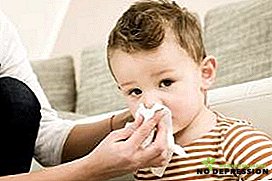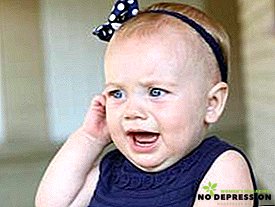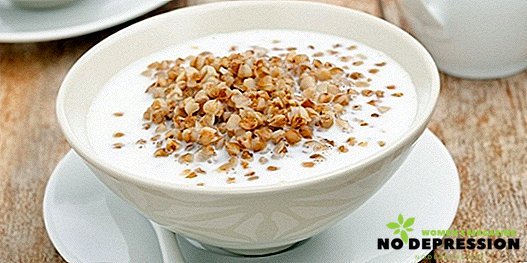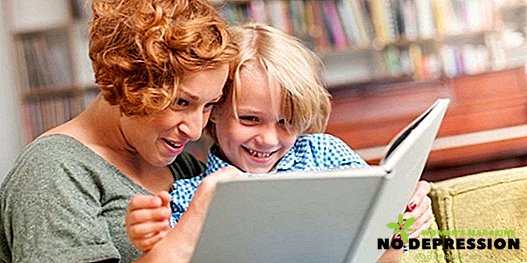Among the common childhood diseases, a significant place should be allocated otitis. About 60% of babies face him before the age of 1 year. The disease brings a lot of trouble, which are accompanied by constant pain in the ear.
It is very important to identify the disease in a timely manner and begin its immediate treatment, this will make it possible to avoid serious complications. So, let's get acquainted with the main types of otitis and find out what parents need to do if your child has symptoms of the disease.

Otitis in children: causes and symptoms
Otitis in a child is called an inflammatory process of an acute or chronic nature that occurs in one of the ear sections. The course of the disease is accompanied by quite painful sensations that bring a lot of discomfort to the baby.
To provoke otitis can a number of the following reasons:
- Cold of any degree;
- Diseases caused by viruses or bacteria;

- Hypothermia;
- Diseases of the throat and nasopharynx;
- Respiratory diseases;
- Weak immunity;
- In the youngest babies, too large an Eustachian tube in the ear can trigger otitis. It is located on the same level with the pharynx. Accordingly, absolutely any liquid can get from the pharynx to the ear and cause inflammatory processes there. That is why it is recommended to feed the infant in a semi-horizontal position.
Most of these causes can be avoided and the risk of disease is minimized. One has only to take care of your child and surround him with attention.
If, nevertheless, the disease began to develop, then it should not be allowed to drift. Try to immediately seek the help of a specialist, then immediately proceed to treatment.
Symptoms of otitis:
- severe sore throat;

- mucous discharge from the nose;
- ear pain, which is characterized by growth;
- refusal to eat, because the additional movements of the jaw and swallowing food will be accompanied by pain;
- If you press on the earlobe, it will cause severe pain, from which the child may even scream;
- strong and sharp temperature rise;
- a sluggish state, replaced by restlessness and nervousness;
- the child may whimper, and with an increase in pain he will cry a great deal, he will constantly touch his ears and twirl his head;
- purulent discharge;
- vomiting and diarrhea.
For these symptoms, it is very difficult to confuse otitis with any other disease.
It will always be characterized by severe pain in the ear, which is almost impossible to endure.
Types and forms of otitis in children
Types of otitis depend on which part of the ear inflammation processes begin. Accordingly, there are only three forms of the course of the disease:
- External otitis. It got its name from the fact that the development of the disease just happens in the outer part of the ear. You can even find it with the naked eye. This is one of the most common types of otitis. Various infections can provoke a disease, and its origin can be non-infectious. In this disease, the skin of the external auditory canal is affected. If not treated, these lesions can become malignant;
- Otitis media In most cases, occurs in young children. A focus of inflammation appears in the Eustachian tube. It is in it, with ARVI or other diseases, that liquid can collect. Various infections lead to inflammatory processes. Otitis media can be acute or chronic;
- Internal otitis or labyrinthitis. One of the most severe cases, as the disease develops in the inner ear. In medicine, they still cannot determine the exact causes of internal otitis. The most common is considered to be various injuries, infections and SARS. There is a perception that this type of otitis may also occur as a result of the running of otitis media.

How to determine otitis in a small child
In order to timely detect any disease in a child under one year old, you need to carefully monitor his behavior. Since at this age the children are still not talking, then all the changes should be noticed by adults. What should alert the young parents?
- The child became restless for no apparent reason. Constant irritability and crying;

- The child does not calm down for a long time;
- The baby may refuse to suck the breast or give preference to only one, with the result that his sore ear will be on the pillow;
- The child tries to hold his head in one position, so that the diseased ear is constantly pressed against the warm and soft pillow;
- Sharp crying when you press his ear on the tragus;
- Body temperature rises instantly.
Emergency care before a medical examination
If your child has been diagnosed with otitis, and a visit to the doctor is postponed (although it is undesirable to do it), he needs to be given first aid to relieve the symptoms. Initially try to numb the ear.
The most common non-steroidal drugs are paracetamol, ibuprofen or naproxen.  They have a wide range of effects, thereby helping to reduce inflammation, reduce fever and eliminate pain. You can use tablets, suspension or suppositories.
They have a wide range of effects, thereby helping to reduce inflammation, reduce fever and eliminate pain. You can use tablets, suspension or suppositories.
Another common remedy for otitis is Otirelax or Otipax ear drops. These drugs have combined properties and help reduce pain and inflammation.
Please note that the drops can only be used if the eardrum has not been damaged (this will be indicated by the absence of discharge from the ear).
All other appointments should be given by a specialist.
Medical care, treatment of otitis media in children with antibiotics
Otitis treatment should have an integrated approach and consist of several stages:
- The first step is to restore the patency of the auditory tube. To do this, the baby’s nose must be filled with vasoconstrictor drops appropriate for the child’s age;
- Anesthetize and minimize inflammation. In this case, you need to use local means;
- Treatment of infection with antibiotics. The action of the drugs should be directed to the ear flora, which will help to quickly eliminate the cause of the disease;
- If necessary, decrease body temperature.
 The physician should examine the patient's ear and, if necessary, clean it from the resulting dried dirt. This will help improve outflow of pus from the ear.
The physician should examine the patient's ear and, if necessary, clean it from the resulting dried dirt. This will help improve outflow of pus from the ear.
Again, antibiotics are not always prescribed. It is necessary to monitor the child's well-being, if no improvement is observed during the day, and the temperature and pain remain the same or even increase, then antibiotic therapy is simply necessary.
In most cases, antibiotics are prescribed immediately after confirmation of the diagnosis in children under 2 years of age. The most common drug for otitis is amoxicillin. If the disease recurs, the doctor may prescribe augmentin.
Opinion Komarovsky on the treatment of otitis media in children
If you have found the first symptoms of otitis media in children, Dr. Komarovsky advises to immediately consult a doctor and make a diagnosis. Having received confirmation of the diagnosis, you need to drip the nose of the baby with vasoconstrictor drops.
According to the doctor, you should not use any ear drops until the specialist gives your recommendations. If strong pains are concerned, they can be reduced with the help of painkillers.
Komarovsky notes that the treatment of otitis is quite long. In no case should you stop taking the medication at the first improvement, as this may provoke a relapse. Just do not forget about the prevention of the disease.
If the first signs of a cold appear, then it cannot be allowed to drift. A running form of the common cold can lead to otitis media, the treatment of which will require more strength and nerves.
How to treat child otitis at home
Depending on the type of otitis, various measures are used to treat the disease. Consider the most common.
If you experience acute otitis, you should use the following recommendations:
- Onion compresses are one of the most effective remedies. For their preparation, you need to chop one onion, wrap it in cheesecloth and put it on the child’s compress with a sore ear;
- In order to warm the ear, you can use the warm salt, wrapping it in the bag beforehand;
- Ear babies can also be heated with a blue lamp. This procedure is carried out no more than 3 times a day for 10 minutes.
In case of purulent otitis it is necessary to make compresses based on 20% propolis tincture prepared with alcohol. Apply a cotton swab soaked in liquid to the diseased ear for 3-4 weeks.
Several recipes for treating otitis media at home:
- Pain and inflammation itself will help eliminate compresses from clay. Clay is bred to a thick texture and transferred to a small piece of cloth. Before you make a compress, the ear canal should be closed with a cotton swab, and then apply clay to your ear for 2 hours;
- From the large bulb it is necessary to cut off the upper part and form a small depression in it. Place there cumin seeds, cover with a cut off top and send to the oven for 30 minutes. Then squeeze the juice. They need to bury their ear at bedtime for a week for three drops;
- 10% tincture of birch buds helps to reduce inflammation. Soak cotton wool tincture and place in the inflamed ear. The procedure should be repeated several times a day.
Treatment of otitis externa should be aimed at eliminating the boil. In addition to medications, the following products are also effective, which can be used at home:
- Warming compresses. They are made on the basis of alcohol or vodka. Vodka and water are diluted in a ratio of 1: 1, after which the infusion should be slightly warmed. Moisten gauze in it and attach it to the auricle, so that it remains open. Warming up time - 2 hours;
- You can apply the plantain or baked onions. This procedure should be carried out until the boil breaks;
- Another effective tool is a tincture of bay leaf. 5 sheets of plants pour a glass of boiling water and insist. Bury in the ear a few drops.
Complications
Cases where otitis therapy was started late or were of an irregular nature can lead to serious complications. Most often in the course of the disease occurs a more severe form of otitis - labyrinthitis. Acute dizziness, tinnitus, a decrease or complete loss of hearing, nausea or vomiting may accompany it.
Among the complications of otitis media is also worth noting paralysis of the facial nerve. If the infection goes deep into the skull, it can lead to meningitis, brain abscesses or encephalitis.
In chronic otitis media, persistent hearing loss may develop, which may adversely affect the child’s intellectual development and speech formation.
Prevention and advice to parents
 As already noted, otitis media is a fairly common disease among children, sometimes it can even be repeated several times a year. In order to protect their child from these troubles, parents should monitor their state of health and help, if necessary, to restore the health of the nasopharynx as soon as possible.
As already noted, otitis media is a fairly common disease among children, sometimes it can even be repeated several times a year. In order to protect their child from these troubles, parents should monitor their state of health and help, if necessary, to restore the health of the nasopharynx as soon as possible.
In no case should mucous membranes dry up, and even the most elementary ARD should always be amenable to timely treatment.
Make sure that there are no smokers in the room where the child is located. If the baby still suffered this disease, then so that it does not happen again, you should try to wean him from the pacifier, and also follow the correct feeding technique (reclining position).
You also need to monitor the child's immunity. Sometimes, even resort to hardening, so that the body can resist viral infections.
Some tips for parents:
- If you decide to start the treatment of the sick ear of a child, using hot-water bottles, alcoholic compresses or dry heat, then begin all actions only after consulting with a specialist. Otherwise, you can provoke not only increased pain, but also the spread of the disease to the deeper ear sections;
- Treatment with drugs begin only after inspection by an otolaryngologist. He must identify the stage of the disease and give an appointment;
- Bathing with this disease is not contraindicated, but you only need to ensure that water does not get into the ear and the body temperature is not elevated.
So, we have added to our knowledge about the disease, as otitis. Unfortunately, every parent can face it.
And remember, start treatment only after consulting with a specialist, do not self-medicate, this can harm your child.
In the next video - additional information about otitis in children from Dr. Komarovsky.















